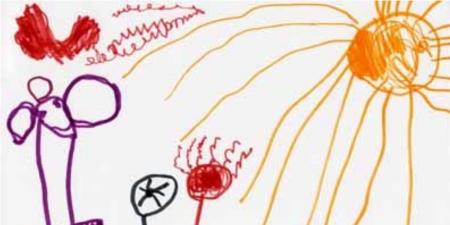Case
Neil was first diagnosed with acute lymphoblastic leukemia at age 3. After induction chemotherapy failed to produce a remission, his family spent the next 6 months traveling around the country trying to find the best doctors and latest chemotherapy options. When they finally decided to seek treatment for Neil at a major children’s hospital hundreds of miles from their rural home, Neil and his mother moved to this city, where he spent the next 3-1/2 years in and out of eventually successful chemotherapy and a bone marrow transplant.
Years later, Neil revealed that most of his early memories involved the staff or patients of the children’s hospital. He certainly remembered good experiences, like the ceremonial head-shaving parties, the local ballet company’s recitals in the hospital, and his close friendships with other patients. But the reality was that Neil had lost many of those friends during his hospital stay, and he had many painful memories, too—the endless nights of nausea and pain, his mother’s constant anxiety about his recovery, and the unexpectedly difficult transition back to “civilian living,” catching up in school and learning to share belongings and his parents’ time with his siblings.
Neil succeeded in putting those painful memories behind him and living the life of an average kid in a small town. He’d developed an enthusiasm for football in long conversations with a football-loving nurse, and he threw himself into playing. However, when he was 14 years old, he began to notice increasing fatigue during practice and games. He didn’t mention it to his mother. During his annual physical, it was noted that he had lost 15 pounds and, when questioned, he revealed his other symptoms. His mother, inconsolable, prepared for another trip to Children’s Hospital.
There, Andrea, a third-year medical student, was assigned to Neil’s case. She, too, shared Neil’s enthusiasm for football, and they developed a rapport. But when Neil began asking Andrea about his diagnosis, she didn’t know how to respond.
Neil’s ALL had, in fact, returned. Because he had relapsed after transplant, only participation in a Phase I trial designed to measure toxicity and maximum dosages of new chemotherapy agents was offered as an option. But his mother had specifically asked the treatment team not to discuss Neil’s diagnosis with him, believing that he couldn’t cope with the news or appreciate its implications.
Meanwhile, Neil confided in Andrea that he would rather die than endure another course of chemotherapy, saying, “It was horrible. I can’t do it again. I just want to go home, but I’m scared my mom and doctors will hate me.”
Commentary
Though this all-too-common scenario raises many topics for discussion, we will focus on nondisclosure requests, assent, and emerging autonomy in pediatric health care decision making, integrating pediatric palliative care into oncology care, and caregiver moral distress. Throughout the article, the term “parent(s)” will be used generally to refer to responsible decision maker(s), and the term “child” will refer to infants, children and young adults cared for by pediatric teams.
Nondisclosure
A request for nondisclosure from the parents of a pediatric patient is unfortunately a common occurrence. Whatever the reason—specific religious or cultural injunctions and fear of causing a child to lose hope or “stop fighting” are the most common—these situations are often a cause of great distress for caregivers, especially those at the bedside, who feel like a gag order has been imposed on them. Research examining disclosure directly from the child’s perspective is lacking; nevertheless, several general themes have been elucidated. Most of the time, the feared harms from disclosure are outweighed by the benefits: children do wish to participate in their own health care decision making and cope more effectively when given honest, developmentally appropriate information [1, 2]; children who are not specifically told about their diagnosis or prognosis often do know more than adults think they do [3], and silence may perpetuate worries or fantasies that are worse than the truth; and opening the channels of communication can substantially reduce suffering [2]. In particular, research demonstrates that families who are encouraged to talk with their children about their illness and their death experience less decisional regret and have less complicated bereavement than families who maintain a position of nondisclosure [1].
Clearly, the best strategy to avoid conflict over disclosure is to prevent an impasse from the beginning. Establishing a relationship with the family that includes the child whenever possible sets the tone from the outset that “outside the door” conversations and deliberate withholding of information from patients are not encouraged. This is not to say that clinicians need to take an intolerant stance toward parental requests for “protection.” There are occasionally religious, cultural, family-centered, and even child-preference reasons not to give children full information unless and until families give permission for such information to be disclosed or do so themselves.
An approach to nondisclosure that will resolve most conflicts includes the following elements:
- Recognize that disclosure is a process, not a binary either/or;
- Establish a culture of openness from the start;
- Partner with parents to preserve hope for miracles, and brainstorm solutions;
- Inform parents that you will not directly contradict their wishes but that you also will not lie to the child;
- Discuss with parents the known benefits of allowing children access to honest information from trusted sources and the known harms that can occur when children are “protected;”
- Engage in a dialogue about the “process” of evolving disclosure to negotiate an approach that is family-centered but also respects the care team’s primary duty to the child-patient;
- Explore and address family fears about clear dissemination of information;
- Involve interdisciplinary team members and trusted family advisors in the conversations;
- Explore what the child already knows and would prefer to know, in front of the parents and separately, if allowed; and
- Employ nonverbal means to elicit comprehension and questions from children whose communication is not primarily verbal.
Though this strategy is appropriate in most situations, it is important to state that telling children the truth is not always the right thing to do, and each situation must be approached individually. For Neil and his mother, directed discussion will probably reveal Neil’s mature appreciation of his medical situation and allow him to assert some control over an otherwise out-of-control reality.
Assent and Concern for Emerging Autonomy
Because Neil is under 18, he is not considered to be competent (a legal term). Competence confers true autonomy, which allows one to give informed consent. Decisions about Neil’s treatment, therefore, will be made by his surrogate decision makers—in this case, his parents—who are presumed to have his best interests in mind at all times unless and until proven otherwise. Because consent is something one can only give for oneself, Neil’s parents actually provide informed permission for his medical treatment.
Even before they reach the age of legal competence or become emancipated minors (by marrying or establishing financial independence, for example), children often possess sufficient decisional capacity to participate in health care decision making for themselves. When treatment decisions are being considered—and especially as the likelihood of cure diminishes—most practitioners support allowing children to exercise decisional capacity to the extent that they are interested and developmentally capable, even without legal competence or emancipation. This process facilitates respect for emerging autonomy, recognizing that autonomy in practice is not a switch that gets flipped on a child’s 18th birthday.
In this scenario, Neil’s next step is enrolling in a Phase I clinical trial. This is research, not treatment, so it requires Neil’s assent. Most investigators (including the Children’s Oncology Group), practitioners, and institutional review boards agree that cognitively typical children age 7 and older possess sufficient capacity to take part in deciding whether or not they should participate in research. They are allowed, at this age, to “dissent,” that is, to refuse. They are not allowed, however, to dissent from treatmentuntil they are older; hence, their assent to treatment-related decisions also comes later.
The purpose of a Phase I clinical trial is to determine toxicity and maximum tolerated dose. Fatal toxicity rates of Phase I clinical trials have traditionally been on the order of 0.5 percent; recently, this has decreased to 0.06 percent. The possibility of direct benefit to participants—in this case, Neil—has historically been roughly 4-6 percent, but recent data indicate that response rates for individual subjects enrolled in Phase I trials are down to 2.5 percent. The research does entail some risks for Neil, which may include side effects from the treatments themselves, as well as a significant impact on his quality of life due to increased time away from home, family, and school. Nevertheless, some children do appreciate the opportunity to be altruistic and may incur personal benefits that make the risks worthwhile. It is crucial, however, that therapeutic misconception does not occur—in other words, families must truly understand the low chance of direct benefit from participation. To ensure that children and families receive adequate, understandable information and make truly informed choices that reflect their goals of care, some clinicians and investigators believe that enrollment in Phase I clinical trials should be a trigger for pediatric palliative care referral.
Integrating Pediatric Palliative Care into Pediatric Oncology Care
Pediatric palliative care (PPC) is most effective for all concerned— patient, family, community, treatment team, and palliative care team—when introduced as early as possible in the course of a child’s chronic, complex, or life-threatening diagnosis. Linking access to PPC with prognosis for financial or psychological reasons (such as fear of dashing hope or signaling failure) is detrimental in various ways, not the least of which is that such linking can restrict or delay access to highly beneficial and effective services. Families and patients are, in fact, capable of maintaining the dual goals of cure- or disease-directed therapy and palliative care.
Despite its documented advantages, PPC remains underused, even in situations like Neil’s. Recent national data from the American Hospital Association reveals a 58.5 percent prevalence of palliative care programs in 2517 hospitals nationwide (not pediatric); this prevalence is almost identical to the 58 percent of Children’s Oncology Group member hospitals that report that PPC services are available to their patients. Due to many barriers outlined in detail in other sources [4, 5], however, the percentage of eligible patients served is far lower.
To improve delivery of PPC along with state-of-the-art oncology care, it is helpful for health care professionals and families alike to recognize the following:
- PPC should not be described as an “either/or” choice for a family, implying that it represents a transition to second-best care; PPC is an accredited, recognized medical specialty that should be available to any child who would benefit from it;
- The goal of PPC involvement is integration with, not replacement of, the oncology team, and the family can gain access to elements of both teams as needed;
- Disease-modifying and palliative care strategies are often synergistic; for example, chemotherapy and radiation may relieve symptoms, while better sleep, nutrition, and pain control may affect tolerance of therapy;
- If a child’s condition worsens, co-management prevents a disruptive transition to a new care team at the worst possible time and decreases feelings of abandonment in both directions (family and care team);
- Co-management provides an umbrella of support throughout the entire emotionally draining process, including additional support for the oncology team, which faces limited time and resources; and
- Effective integration allows the child and family self-determination about treatment options and promotes health care justice through access to high-quality care.
Neil’s case includes several instances in which palliative care team involvement could be beneficial for him and his family. Nevertheless, knowing when to consult palliative care can be challenging for clinicians. In Neil’s case, while it was reasonable to think (and even expect) that his initial treatment course would lead to a cure, PPC could presumably have been helpful in mitigating some of the suffering that Neil experienced even then. With his relapse, the need for integration becomes even clearer. Many PPC teams are available for any child with a life-threatening condition (which would, in fact, include almost any type of oncologic problem). Depending on the services available from the oncology team, having an additional support service to focus on symptoms, sibling adjustment, and other areas of child or family suffering is ideal. In reality, though, resource availability may preclude PPC team involvement with each new diagnosis, so some selection criteria are appropriate.
In settings where hospital- or community-based PPC is available, oncology treatment teams can use the following strategies to determine which children and families might benefit from PPC:
- Think about appropriate points at which PPC might be logically introduced, such as: family is overwhelmed at diagnosis; Phase I enrollment; time of relapse or recurrence; development of serious complications; ICU admission or transfer.
- Treat PPC as an adjunct medical specialty that comes as part of the package with an oncology diagnosis, rather than as an optional service. Families should be informed that they will be receiving a palliative care consult rather than asked if they want one, as this shifts the burden from the family to the caregivers. This is, after all, the way in which medical consultation is done in other circumstances.
- Think up front about list of diagnoses for which there is honest acknowledgment of the likelihood of cure with no burdensome treatment. The many medical circumstances outside that small group are candidates for considering PPC.
- Forget the idea of prognosis entirely and involve PPC to enhance resource management for the complex needs of family, treatment team and community.
Compassionate Care for Ourselves as Caregivers
Finally, an important dimension of Neil’s story involves our obligation to care for each other as caregivers. Support for staff, including the medical student, is of primary importance in avoiding moral distress, unacknowledged grief, and burnout. In particular, Andrea is being put in a potentially difficult situation by being asked not to disclose information to Neil, with whom she has a primary relationship. As mentioned above, it is often the direct or bedside caregivers who are the most at risk for moral distress in situations in which families have forbidden disclosure. Medical students, residents, bedside nurses, and other staff must be incorporated into the conversations about the plan of care and, specifically, the plan for handling nondisclosure.
In a true family-centered care setting, the unit of care is not just the affected child. For involved caregivers, the duty of fidelity instructs that our child patient is our primary concern and that we must make medical and other decisions in this patient’s best interest. But it is the family who will live with the consequences of the decisions long after the illness episode is over, and ignoring this reality to stand on bioethical principle alone is not helpful in day-to-day care. Navigating potential or actual conflict in this arena—such as between Neil’s mother and the treatment team—can be enormously stressful for those who feel caught in the middle like Andrea, who has not yet developed the skills and maturity to navigate the situation expertly. Support for all involved must be provided by the team, and outside ethics consultation can be sought if individual caregivers feel unsettled with decisions being made. At the end of the day, no clinician should be obligated to participate in a plan of care that he or she objects to on moral grounds; however, it is the duty of that clinician to recuse her- or himself rather than acting in a passive aggressive or subversive manner.
Conclusion
This article has focused on several of the more common elements that can be distressing in situations like Neil’s but can also present opportunities for skillful and effective clinicians to intervene to facilitate patient, family, and staff dignity and healing. For more in-depth treatment of these and other related topics, an abbreviated list of suggested readings is included.
References
- Kreicbergs U, Valdimarsdottir U, Onelov E, Henter JI, Steineck G. Talking about death with children who have severe malignant disease. N Engl J Med. 2004;351(12):1175-1186.
- Hinds PS, Drew D, Oakes LL, et al. End-of-life care preferences of pediatric patients with cancer. J Clin Oncol. 2005;23(36):9146-9154.
- Bluebond-Langner M, Belasco JB, Goldman A, Belasco C. Understanding parents’ approaches to care and treatment of children with cancer when standard therapy has failed. J Clin Oncol. 2007;25(17):2414-2419.
- Himelstein BP, Hilden JM, Boldt AM, Weissman D. Pediatric palliative care. N Engl J Med. 2004;350(17):1752-1762.
-
Wolfe J, Hammel JF, Edward KE, et al. Easing of suffering in children with cancer at the end of life: is care changing? J Clin Oncol. 2008;26(10):1717-1723.



